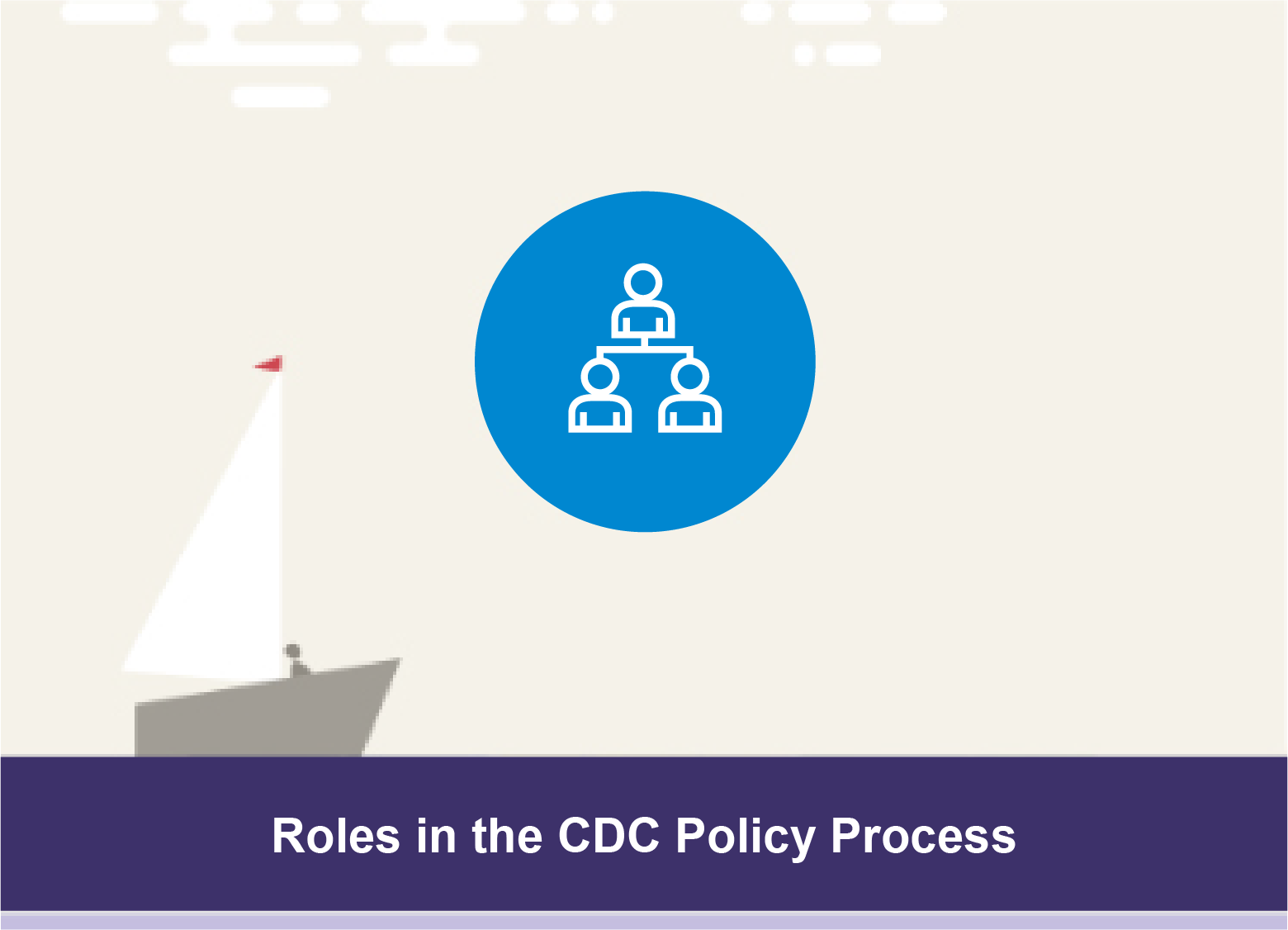Key points
- Government public health professionals can help translate evidence and science into policy
- CDC's Policy Process consist of five domains and two overarching domains
- Government public health professionals play an important role in each domain

Overview
Public health is concerned with protecting the health of communities and entire populations. Whether as small as a local neighborhood, or as big as an entire country, policy is one potentially effective way to improve the health of populations.
The goal of this overview is to foster a common understanding of what policy is and the process by which it is conceptualized, developed, adopted, and evaluated. Policy development is rarely a linear process; often the domains of the policy cycle overlap or occur out of order. However, in the ideal scenario, a problem is defined, potential policy solutions are identified, analyzed, and prioritized, and the best solution is adopted and evaluated.
Governmental public health professionals play an important role in the policy process, for example, by conducting policy analysis, communicating findings, developing partnerships, and promoting and implementing evidence-based interventions. CDC and governmental public health partners may find this document useful in their efforts to translate evidence and science into policy. We have included the potential role of governmental public health for each of the domains as examples.
"Policy" is defined as a law, regulation, procedure, administrative action, incentive, or voluntary practice of governments and other institutions.

I. Problem Identification
Problem Identification: Clarify and frame the problem or issue in terms of the effect on population health.
- Collect, summarize, and interpret information relevant to a problem or issue (e.g., nature of the problem, causes of the problem)
- Define the characteristics (e.g., frequency, severity, scope, economic and budgetary impacts) of the problem or issue
- Describe the characteristics of who the problem or issue affects (e.g., age, race/ethnicity, gender, socio-economic status, education level, etc.)
- Identify gaps in the data
- Frame the problem or issue in a way that lends itself to potential policy solutions, is factual, and is easy for the audience to understand
Potential Role of Governmental Public Health
II. Policy Analysis
Policy Analysis: Identify different policy options to address the problem/issue; use quantitative and qualitative methods to evaluate the most effectiveness, efficiency, and feasibility of the policy options.
- Research and identify policy options by conducting an environmental scan and engaging stakeholders
- Describe: a) how the policy will impact morbidity and mortality (health impact), b) the costs to implement the policy and how the costs compare with the benefits (economic and budgetary impacts) and c) the political and operational factors associated with adoption and implementation (feasibility)
- Assess and prioritize policy options
Potential Role of Governmental Public Health
III. Strategy and Policy Development
Strategy and Policy Development: Identify the strategy for getting the policy adopted and how the policy will operate.
- Identify how the policy will operate and what is needed for policy enactment and implementation (e.g., understand context and identify experience, knowledge, and abilities needed)
- Determine how to engage stakeholders and policy actors
- Consider drafting the policy (law, regulation, procedures, actions, etc.) to share with stakeholders for feedback
Potential Role of Governmental Public Health
IV. Policy Enactment
Policy Enactment: Follow internal or external procedures for getting policy enacted or passed.
- Enact laws, regulations, procedures, administrative actions, incentives, or voluntary practice
Potential Role of Governmental Public Health
V. Policy Implementation
Policy Implementation: Translate the enacted policy into action, monitor uptake, and ensure full implementation.
- Translate policy into operational practice and define implementation standards
- Implement regulations, guidelines, recommendations, directives and organizational policies
- Identify indicators and metrics to evaluate implementation and impact of the policy
- Coordinate resources and build capacity of personnel to implement policy
- Assess implementation and ensure compliance with policy
- Support post-implementation sustainability of policy
Potential Role of Governmental Public Health
Overarching Domains
The following activities should be considered throughout each of the five domains.
Stakeholder Engagement and Education: Identify and connect with decision-makers, partners, those affected by the policy, and the general public.
- Identify key stakeholders, including supporters and opponents of the policy (e.g., community members, decision-makers, nonprofit, and for-profit agencies)
- Assess relevant characteristics (e.g., knowledge, attitudes, beliefs, and behaviors; information needs)
- Implement audience-specific communication strategies and deliver tailored messages and materials
- Solicit input and gather feedback
Potential Role of Governmental Public Health
Evaluation: Formally assess the appropriate steps of the policy cycle, including the impact and outcomes of the policy.
- Define evaluation needs, purpose, and intended uses and users
- Conduct evaluation of prioritized evaluation questions (e.g., was the problem defined in a way that prioritized action, how were stakeholders engaged, is the policy being implemented as intended, what is the impact of the policy)
- Disseminate evaluation results and facilitate use
Potential Role of Governmental Public Health
- This text is only intended to provide clarifying examples and not intended to list all of the roles Governmental Public Health can play. Please note that federal law prohibits certain lobbying related activities by CDC at the federal, state and local level. There may be other restrictions on lobbying related activities of which public health professionals should be aware.
